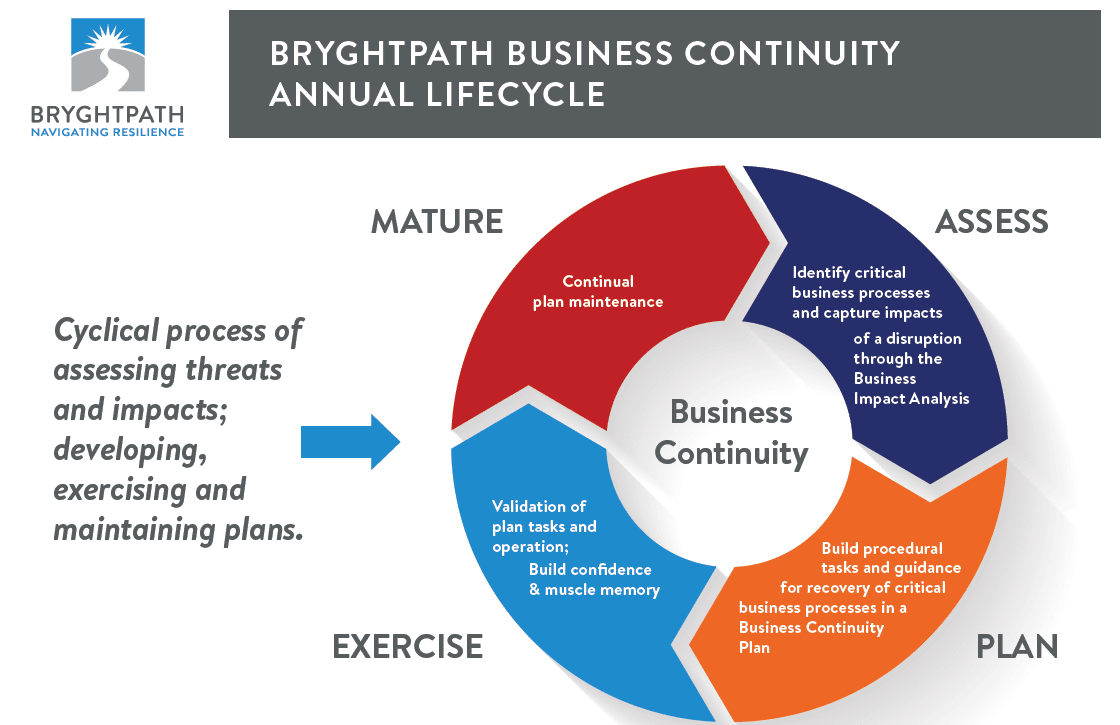The business continuity management lifecycle (BCM lifecycle) is a critical aspect of an effective business continuity program. It ensures that your company can continue to operate in the event of an emergency or natural disaster. The goal is to create a plan that minimizes disruption to your operations and provides you with the best possible outcomes during times of crisis.
As part of this process, it’s important to understand the key steps involved in creating an effective BCM program and how they relate to each other — in this article, we’ll go over those steps so you can implement them effectively at your organization!
You can download our graphic showing the Business Continuity Lifecycle exactly how we implement it in our consulting engagements in our Resource Library.
Understand the BCM Lifecycle
The BCM lifecycle is the process of continually improving your business continuity plan. It’s not a one-time event, but rather an ongoing process that takes place throughout the lifetime of your organization.
The BCM Lifecycle is a continuous process of improving the effectiveness of your BCM program and can include any or all of these activities:
- Developing an initial Business Continuity Plan (BCP) – This step involves creating strategies for recovering from common issues like power outages or natural disasters by identifying what actions need to be taken and who will perform them in order to keep business operations running smoothly during those times when they are disrupted by an incident or disaster event.
- Exercising/Auditing – After developing plans, it’s important to exercise them periodically so that you know if they’re effective at handling different types of events before something happens; this also helps identify gaps in coverage so that they can be filled before there’s ever any downtime due to lack thereof
Define your business resilience goals in your BCM Lifecycle
The first step in the BCM lifecycle is to define your business resilience goals. This can be done by answering questions such as:
- What do you want to achieve?
- How will success be measured?
These questions will help you determine how your organization measures up against industry standards and benchmarks, and it will provide insight into what areas need improvement for future projects. For example, if one of your goals is to improve data center availability by 20% over three years, then this could lead directly into developing a plan for mitigating risk during planned maintenance activities or installing backup generators at remote sites where power outages are common (or both).
Determine the risks and threats that could impact your business
- External risk factors: External risks are those that are outside your control and can include natural disasters, severe weather events and pandemics.
- Internal risk factors: Internal risks are those you have some control over but may not be aware of. For example, if an employee has access to sensitive data on your network and they leave the organisation without handing over their credentials or device, this could be considered an internal threat because it is something that happens within your organisation rather than outside of it.
- Business continuity risks (BCRs): These are risks related specifically to ensuring that critical functions continue operating during a crisis or disaster situation so that you can meet customer needs in order to sustain business operations as usual after any disruption has occurred–and preferably sooner than later! Some examples include losing key personnel due to illness or injury; having insufficient power capacity at critical locations such as back-up sites where employees need access 24/7; not having sufficient funding available for restoring systems after an attack against them successfully shuts down operations; etc…
Conduct a business impact analysis (BIA)
Conducting a BIA is an essential step in the BCM lifecycle. It helps you to identify the critical functions, processes and systems that need to be protected from disruption. This includes information on:
- Critical assets (e.g., buildings, data centres)
- Key personnel (e.g., key staff members)
- Business critical services (e.g., customer facing websites)
The BIA will also include details of how these assets could be impacted by an incident or disaster scenario. For example:
- The impact on people’s ability to access your premises if there are delays in getting through security checks at entrances due to large numbers of visitors arriving at once; or
- How long it would take for your IT support team to restore computer systems after power outages caused by severe weather conditions
Learn more about the Business Impact Analysis in our article How to Conduct a Business Impact Analysis.
Create a BCM plan that aligns with your overall business continuity strategy and goals.
As you begin the process of building your BCM plan, it’s important to remember that this document should align with the business strategy and goals. If you’re not sure what those are, start by asking yourself some questions:
- What do I want my organization to look like in five years?
- What are our top priorities right now?
- How can we make them happen faster or better than competitors do today?
Practice your new BCM plan through a business continuity exercise
Practice your new BCM plan through a business continuity exercise
Once you have developed and tested your BCM plan, it is important to practice using the plan. This can be done by conducting a business continuity exercise (BCX). A BCX simulates an actual emergency event in your organization and allows you to test how well employees respond under pressure, as well as see if there are areas where improvements need to be made before an actual disaster strikes.
In order for this process to work effectively, it’s important that everyone knows what their role is during an emergency situation; otherwise, communication may break down between departments or teams within the company due to confusion about who does what when faced with a crisis situation like an earthquake or fire at work. It’s also helpful if people know how long they’re expected not only survive but also continue working after such events take place–this way there won’t be any confusion about whether or not someone’s job might still exist after recovering from whatever damage occurred during said catastrophe!
Incorporate the lessons learned from your exercise back into your BCM Lifecycle
- Incorporate the lessons learned from your exercise back into your BCM plans.
- Update your BCM plan on a regular basis.
- Your BCM plan is a living document that needs to be updated after an exercise or emergency, as well as any time there is change in business operations or technology that impacts the organization’s ability to continue operating in an effective manner during an emergency situation.
The key to creating a successful BCM program is understanding what you need to protect and then identifying the right solutions to meet those needs
The key to creating a successful BCM program is understanding what you need to protect and then identifying the right solutions to meet those needs. The first step in this process is understanding your business, its risks, and how those risks impact its ability to continue operating as usual. Once you have this information, it’s time for step two: determining how much downtime or disruption from any given event would cause irreparable harm. If there are multiple options for addressing each risk (for example, different types of backup systems), then we recommend prioritizing them based on their cost-effectiveness relative to each other and/or their ability to mitigate specific threats (e.g., ransomware).
Once you’ve identified which risks are most important based on cost-effectiveness measures like these–and also factoring in things like legal requirements–you’ll know what types of solutions will work best for protecting against those threats while still allowing your company flexibility over how they’re implemented (e.g., cloud vs on-premises). Finally comes practicing using these plans until everyone knows exactly what steps need taken during an emergency situation so nothing gets overlooked when lives could depend on it!
Conclusion
The BCM lifecycle is a journey, not a destination. It’s important to remember that your business will continue to evolve over time, which means so will your BCM program. The key is making sure that your program keeps pace with these changes by continually identifying new threats and risks as well as updating existing plans so they remain relevant in today’s ever-changing world.
Want to work with us or learn more about Business Continuity?
- Our proprietary Resiliency Diagnosis process is the perfect way to advance your business continuity & crisis management program. Our thorough standards-based review culminates in a full report, maturity model scoring, and a clear set of recommendations for improvement.
- Our Business Continuity (including effective Business Continuity Lifecycles) & Crisis Management services help you rapidly grow and mature your program to ensure your organization is prepared for the storms that lie ahead.
- Our Ultimate Guide to Business Continuity contains everything you need to know about Business Continuity
- Our free Business Continuity 101 Introductory Course may help you with an introduction to the world of business continuity – and help prepare your organization for your next disruption. Our paid 5-Day Business Continuity Accelerator might just be the thing you need to jumpstart your business continuity program.
- Learn about our Free Resources, including articles, a resource library, white papers, reports, free introductory courses, webinars, and more.
- Set up an initial call with us to chat further about how we might be able to work together.



 Enhancing Business Resilience through Executive Engagement
Enhancing Business Resilience through Executive Engagement